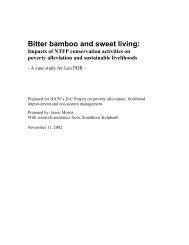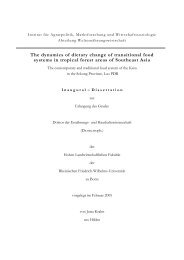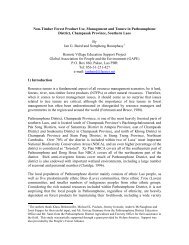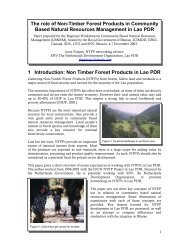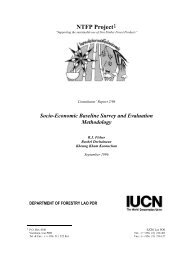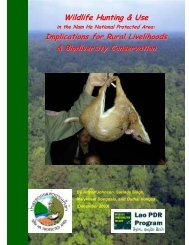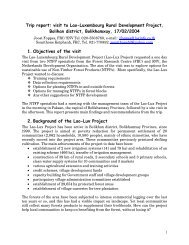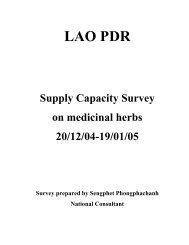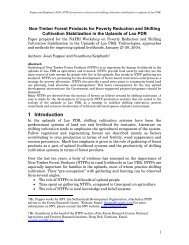Create successful ePaper yourself
Turn your PDF publications into a flip-book with our unique Google optimized e-Paper software.
5 Traditi<strong>on</strong>al use areas and boundaries<br />
Where do villagers collect their NTFP’s from? We used three data collecti<strong>on</strong> methods to<br />
answer this questi<strong>on</strong>: land-use type ranking, forest block ranking and sketch mapping. In<br />
additi<strong>on</strong>, we did rapid forest inventories in each village (see Annex 5). In general villagers<br />
discern main land use types such as dry dipterocarp and evergreen forests, paddy fields and<br />
upland rice/fallow fields , streams and p<strong>on</strong>ds etc. Within the evergreen forest, they discern<br />
many forest blocks, usually delineated by streams “huay” or other landscape features such as<br />
roads or rocks.<br />
Firstly we asked villagers to define and rank main land-use types where NTFP’s are<br />
collected. (see table 12). Interestingly, an overall 60 % of NTFP’s was classified as collected<br />
from streams, p<strong>on</strong>ds, paddy fields, grass fields, and fallwo fields which are not strictly forest<br />
areas. These areas are likely to be mostly situated within the inundati<strong>on</strong> z<strong>on</strong>e. Only 25 % was<br />
said to be derived for the evergreen forest and mountains. The proposed resettlement area<br />
falls under what villagers would call “pa kok”. Only 16 % of all NTFP’s are said to be<br />
derived from this area. It is also remarkable that little difference in opini<strong>on</strong> was found<br />
between groups of men and women <strong>on</strong> this issue.<br />
Table 12:<br />
Collecti<strong>on</strong> areas for NTFP’s, ranked according to relative importance, by<br />
villagers in 3 villages <strong>on</strong> the <strong>Nakai</strong> <strong>Plate</strong>au, March 1997.<br />
Village <strong>Nakai</strong> Sopphene Thalang All<br />
Landtype men/women men women men women men women men women overall<br />
d<strong>on</strong>g/pou evergreen forest/mountains 15% 29% 25% 25% 32% 22% 24% 25% 25%<br />
kok dry dipterocarp/pine forests 25% 13% 14% 20% 8% 16% 15% 16% 16%<br />
palao fallow regrowth 20% 26% 14% 15% 8% 18% 14% 20% 17%<br />
houay/n<strong>on</strong>g streams/p<strong>on</strong>ds 25% 22% 38% 30% 33% 33% 32% 28% 30%<br />
th<strong>on</strong>g/naa grassfields/paddy fields 15% 10% 10% 10% 20% 12% 15% 11% 13%<br />
100% 100% 100% 100% 100% 100% 100% 100% 100%<br />
Sec<strong>on</strong>dly, we would ask villagers to specifically list and rank the evergreen forest areas as to<br />
their importance for collecting NTFP’s (see Annex 1). We found that villagers are able to<br />
identify forest blocks and main products collected per block. Villagers estimates of yield<br />
potential for all blocks make an interesting comparis<strong>on</strong> with the estimated total producti<strong>on</strong><br />
per village, calculated from the individual family survey data (see table 13). In some cases,<br />
both estimates are remarkably close, e.g. in Ban Kh<strong>on</strong>e ken, Ban Ka-oy, in others they are<br />
very different, e.g. Ban Thalang, which begs the questi<strong>on</strong> which of the two estimates is<br />
closest to the truth. Unfortunately, there was no opportunity to feed back these differences to<br />
the villagers involved. For now we can <strong>on</strong>ly c<strong>on</strong>clude that villagers can make c<strong>on</strong>sistent<br />
estimates of NTFP’s but the data require back-checking and may in some cases<br />
underestimate the real harvest of NTFP’s. Forest block ranking is potentially a powerful and<br />
quick tool, but it should be used with cauti<strong>on</strong>.<br />
Thirdly, we asked villagers could usually draw a map of their resource use area and name<br />
various landscape elements and forest blocks (see Annex 6).These area’s can more or less be<br />
recognised <strong>on</strong> the topographical maps. It would take a special survey to define the exact<br />
boundaries of each block and its size properly. Such an exercise could not be undertaken<br />
within the limited time available for this study. More intensive mapping should be d<strong>on</strong>e using



